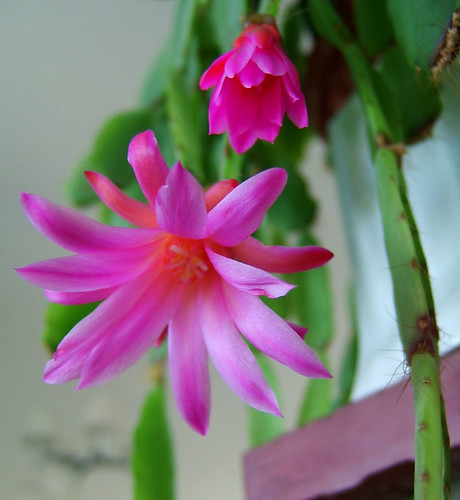Schlumbergera gaertneri (along with cultivars Schlumbergera x graeseri and rosea) is better known as Easter cactus. Its common name refers to its blooming time: lovely pink or white flowers should appear during late Spring.
Many people just buy this plant for a pop of color on the Easter brunch table, but with the right care your Easter cactus can actually thrive and rebloom for many more years.
Keep reading for everything you need to know about Easter cactus care and growing Easter cacti at home!
| Name(s) (common, scientific) | Easter cactus, Spring cactus, Whitsun cactus, Schlumbergera gaertneri (formerly Hatiora gaertneri, sometimes incorrectly Rhipsalidopsis gaertneri) |
| Difficulty level | Intermediate |
| Recommended lighting | Bright indirect |
| Water | Keep lightly moist |
| Soil type | Gritty |
Easter cactus care
Contrary to many of the other succulents we commonly keep as houseplants, Easter cacti are epiphytic and naturally occur in Brazilian rainforests. Their growth pattern (on trees and rocks) and natural habitat mean they require different care than their desert cousins: more water and less light.
Easter cactus care is similar to that of other ‘seasonal’ cacti from the Schlumbergera genus, which bloom during Wintertime.
Did you know? The Easter cactus has been through a lot of scientifical confusion. It was first classified as an Ephiphyllum (another jungle cactus), then as Schlumbergera, then as Rhipsalis, Epiphyllopsis, Rhipsalidopsis and then Hatiora. Now, it’s been moved back to Schlumbergera, although it’s still often referred to as Rhipsalidopsis gaertneri.
Schlumbergera gaertneri

Easter cactus light, location and temperature
Light
Because Easter cacti naturally occur in forests where most direct sunlight is blocked out by larger trees, they don’t appreciate being exposed to the sun’s scorching afternoon rays. Instead, provide bright but indirect light and possibly a little early morning or late evening sun.
Easter cactus blooming is triggered by both light and temperature. To prevent getting few or no flowers, make sure your Easter cactus isn’t exposed to any light at all during the night in the months before the blooming period.
This means that starting around January, you should take care to fully close the curtains and turn off all lights in the room your cactus is in after the sun sets.
Location
Rainforests like the ones these cacti call home are quite humid, which means the average home might be a little too dry for them.
Provide the humidity your Easter cactus loves by placing it in the kitchen/bathroom or mist it daily to at least provide a little extra moisture.
Temperature
Easter cacti are tropical plants, which means they don’t deal well with very low temperatures. Don’t expose your Easter cactus to frost! Although this plant can be placed outside during summertime it should be back indoors before temperatures start dropping.
A relatively low Winter temperature is needed before buds have formed, but once the plant is getting ready to bloom a warmer environment is required.
Easter cactus soil and planting
Easter cacti are epiphytes that grow on trees and rocks, which means they aren’t used to their roots being in compact soil. To imitate their natural growing habits, use a light and coarse mixture. You can buy succulent soil, but it’s just as easy to mix it yourself using equal parts perlite and potting soil.
When planting your Easter cactus keep in mind that its leaves will naturally start hanging downwards as it grows larger. This means it’s a great option for a hanging pot.
Watering Easter cactus
Watering is where things often go wrong with Easter cactus care. The fact that they’re cacti leads many plant lovers to believe these plants don’t need a lot of water and that their soil should be very dry at all times. As a result, the plant will quickly start looking droopy, wrinkeled and sad.
Luckily, this can easily be prevented by treating your Easter cactus as the forest cactus it is. Try to keep it lightly moist at all times while preventing it from getting too wet: constantly soaked soil will quickly lead to root rot. The only exception here is the period after blooming. To give the plant some rest, restrict watering for a month or so.
Your exact watering schedule will depend on the amount of light your plant is getting, but watering once or twice a week should be a good start.

Easter cactus fertilizer
You can feed Easter cacti every two weeks or so using a balanced liquid fertilizer. Stop feeding for a bit during the resting period and then restart if desired.
Propagating Easter cactus
As with most succulents, propagating is not too much of a challenge. Just remove a piece consisting of a few leaf segments, let it dry for a few days and then stick it in a coarse soil mixture.
Buying Easter cactus
Plant stores and garden centers are flooded with Easter cacti during their blooming period. Outside of the Spring season you might have a lot more trouble finding them in stores.
Is Easter cactus toxic to cats and dogs?
Easter cacti are not toxic to cats and dogs, so although ingestion of houseplants is rarely pleasant for pets there is no real danger.
Cover photo: Hatiora gaertneri ‘Sagitta’ 02.JPG (cropped, CC BY-SA 3.0)






